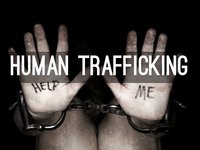Human Trafficking
Human Trafficking
Update canvas image
Image uploaded by:
Group editing is not supported in IE8.
Sorry, group editing is not supported in your browser. Editing is supported in Internet Explorer 9 or later, Chrome, Safari, and Firefox.
Select Image Crop

Update logo
Logo uploaded by: SFC James J. Palmer IV aka "JP4"

Human Trafficking
Upgrade your browser in order to edit this page.
 Edit
Edit
About
Human trafficking is the trade of humans, most commonly for the purpose of sexual slavery, forced labor, or commercial sexual exploitation for the trafficker or others. This may encompass providing a spouse in the context of forced marriage, or the extraction of organs or tissues, including for surrogacy and ova removal. Human trafficking can occur within a country or trans-nationally. Human trafficking is a crime against the person because of the violation of the victim's rights of movement through coercion and because of their commercial exploitation. Human trafficking is the trade in people, and does not necessarily involve the movement of the person from one place to another.
According to the International Labour Organization (ILO), forced labor alone (one component of human trafficking) generates an estimated $150 billion in profits per annum as of 2014. In 2012, the ILO estimated that 21 million victims are trapped in modern-day slavery. Of these, 14.2 million (68%) were exploited for labor, 4.5 million (22%) were sexually exploited, and 2.2 million (10%) were exploited in state-imposed forced labor.
Human trafficking is thought to be one of the fastest-growing activities of trans-national criminal organizations.
Human trafficking is condemned as a violation of human rights by international conventions. In addition, human trafficking is subject to a directive in the European Union.
Most recent contributors: SFC James J. Palmer IV aka "JP4"




